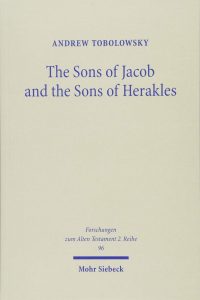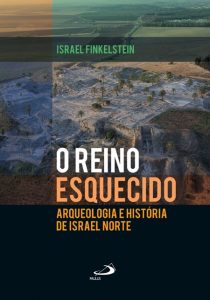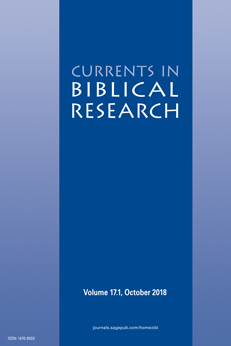:. A História de Israel e Judá na pesquisa atual I
:. A História de Israel e Judá na pesquisa atual II
:. A História de Israel e Judá na pesquisa atual III
:. A História de Israel e Judá na pesquisa atual IV
:. A História de Israel e Judá na pesquisa atual V
TOBOLOWSKY, A. Israelite and Judahite History in Contemporary Theoretical Approaches. Currents in Biblical Research, Vol. 17(1), 2018, p. 33-58.
Este artigo de Andrew Tobolowsky, História israelita e judaíta em abordagens acadêmicas contemporâneas, analisa a evolução do estudo das histórias de Israel e Judá, com ênfase nos últimos dez anos. Durante esse período, tem havido um interesse crescente em evidências extrabíblicas como o principal meio de construir histórias abrangentes, e um renascimento do interesse em teorias pós-modernas. Este estudo oferece uma discussão geral sobre as tendências da última década, considerando a possibilidade dos autores judaítas só terem assumido uma identidade israelita após a queda de Israel [= reino do norte]. Depois de mostrar as principais tendências nos estudos da Bíblia e da História de Israel de modo genérico, o autor aborda o período pré-monárquico, a monarquia unida, os dois reinos de Israel e Judá e o exílio babilônico e, por fim, a época persa.
This article surveys developments in the study of the histories of ancient Israel and Judah with a focus on the last ten years. Over that period there has been an increased focus on extrabiblical evidence, over biblical text, as the primary means of constructing comprehensive histories, and a revival of interest in post-modern and linguistic-turn theories with respect to establishing what kinds of histories should be written. This study offers a general discussion of the last decade’s trends; an inquiry into the possibility that Judahite authors only assumed an Israelite identity after the fall of Israel; and an era-by-era investigation of particular developments in how scholars think about the various traditional periods of Israelite and Judahite history. The latter inquiry spans the pre-monarchical period to the Persian period.
Andrew Tobolowsky: Visiting Assistant Professor at the College of William and Mary in Williamsburg, Virginia, USA.
Sempre que o assunto tiver sido tratado em minha página, Ayrton’s Biblical Page, ou neste blog, Observatório Bíblico, colocarei um link. As principais obras citadas terão links para a Amazon.com.br. O texto em português é um resumo e uma tradução livre minha. O texto em inglês na parte final do post é citação do artigo. A publicação será feita em 5 postagens.
2. Sentimento pan-israelita e o período pré-monárquico – Panisraeliteism and the Pre-Monarchical Period
A ideia, que tem atraído um bom número de pesquisadores, é a seguinte: enquanto Israel existia, ou pelo menos na maior parte de sua existência, os judaítas não se consideravam etnicamente israelitas. Os judaítas teriam se apropriado da identidade israelita em algum momento após a queda de Israel [Samaria caiu em 722 a.C.].
Esta proposta bastante radical foi feita por estudiosos de origens diferentes e, no mínimo, podemos dizer que é extremamente difícil desmenti-la. De uma perspectiva  extrabíblica, como notaram Daniel E. Fleming, em 2012, e Schneider, em 2002, nenhuma inscrição descreve claramente uma relação entre os reinos independentes de Israel e Judá. Isto é particularmente surpreendente no caso dos materiais neoassírios porque, como observa Schneider, os assírios já estavam controlando a região havia uns 130 anos.
extrabíblica, como notaram Daniel E. Fleming, em 2012, e Schneider, em 2002, nenhuma inscrição descreve claramente uma relação entre os reinos independentes de Israel e Judá. Isto é particularmente surpreendente no caso dos materiais neoassírios porque, como observa Schneider, os assírios já estavam controlando a região havia uns 130 anos.
Também parece que a maioria do material bíblico datado de períodos anteriores à queda de Israel exibe uma falta similar de declarações claras a esse respeito. Mas a questão é terrivelmente complexa por disputas contínuas sobre a datação de textos bíblicos. Um estudioso que defenda a opinião de que a história da ascensão de Davi ao trono é essencialmente um texto do século IX, por exemplo, dificilmente abraçaria essa história reconstruída de sentimentos étnicos. Ainda assim, em materiais proféticos, parece haver uma diferença notável entre como e com que frequência a relação entre Judá e Israel é descrita em textos supostamente mais antigos e como essas coisas são apresentadas nos livros de Jeremias, Ezequiel e, mais tarde, partes de Isaías. E o autor defende que este sentimento pan-israelita pode ser entendido em paralelo com o pan-helenismo que deu uma identidade grega a grupos regionais independentes.
Esta ideia aparece em Philip R. Davies, 2007, e em Axel Knauf, 2006. Mas eles entendem que isto ter-se-ia dado após o exílio babilônico, resgatando uma identidade israelita mantida viva na região de Benjamin. Entretanto, K. P. Hong, em 2013, e outros autores pensam que isto pode ter acontecido logo após a queda de Israel, portanto, ainda no século VIII a.C.
Mas há pouco consenso quanto aos detalhes. Assim:
. alguns argumentam que embora o pan-israelismo tenha ocorrido após a queda de Israel, suas raízes já aparecem na relação histórica entre os dois reinos de Israel e Judá: H. G. M. Williamson, 2001; Reinhard G. Kratz, 2005; Daniel E. Fleming, 2012
. outros dizem que este fenômeno foi desencadeado pela chegada dos refugiados de Israel no sul: Israel Finkelstein e Neil Asher Silberman, 2001 e Israel Finkelstein e Neil Asher Silberman, 2006
. e há os que negam a existência desses refugiados: Nadav Na’aman, 2014; P. Guillaume, 2008
. alguns sugeriram que a primeira história pan-israelita – isto é, a primeira composição a fornecer um mito para a afirmação de Judá sobre a identidade israelita – é o resultado do entrelaçamento das tradições do norte sobre Saul com as tradições do sul sobre Davi: Israel Finkelstein, 2013; J. L. Wright, 2014
. Andrew Tobolowsky, em 2017, argumenta que as narrativas monárquicas e patriarcais unidas, tanto quanto a narrativa do êxodo, foram originalmente produzidas como mitos independentes explicando as origens do pan-israelismo. No entanto, este trabalho também sugere que eles apareceram na forma bíblica como história familiar somente após o desenvolvimento do conceito das tribos como “filhos de Jacó”, que teria acontecido apenas no final da época persa, permitindo uma narrativa coerente de um passado étnico compartilhado.
As noted above, we will start our chronological discussion of developments in the study of the Bible and the past with a relatively new but potentially quite disruptive proposal that has begun to gather a fair share of adherents. This is the idea that Judahites never considered themselves to be ethnically Israelite while Israel still existed, or at least for most of the time that Israel existed, but instead appropriated Israelite identity at some point after Israel fell. This quite radical proposal has been advanced by scholars from rather diverse backgrounds and at the very least we can say that it is remarkably difficult to disprove. From an extrabiblical perspective, as both Fleming and Schneider have noted, no inscriptional material clearly describes a relationship between the independent kingdoms of Israel and Judah (Fleming 2012: xii; Schneider 2002). This is particularly surprising in the case of the Neo-Assyrian materials because, as Schneider notes, they were closely ‘engaged in the area for more than 130 years’ (2002: 14).
It also seems as if most biblical material dated to periods prior to the fall of Israel exhibits a similar lack of clear statements in this regard. What this should be understood to mean depends, of course, on where we decide to put the burden of proof, and the issue is made terribly complex by ongoing disputes about the dating of biblical texts. A scholar espousing the view that the History of David’s Rise is essentially a ninth-century text, for example, would be unlikely to embrace this reconstructed history of ethnic sentiments. Still, in prophetic materials there seems to be a notable difference between how and how frequently the relationship between Judah and Israel is described in texts usually presumed to be early and how those things are presented in the books of Jeremiah, Ezekiel, and later parts of Isaiah.
I and others have referred to the possible assumption of Israelite identity by Judahites as the development of ‘Panisraelite sentiment’ and in my opinion the term is valuable for its ready comparison with Panhellenism—the rather slow building of the familiar, embracing the concept of Greek identity out of originally independent regional identities, often through narrative expansion.
 As with many ideas of this sort, the concept of ‘Panisraeliteism’ has its origins in the work of Philip Davies, who has used it at various points to evolve his conception of the way the biblical text ‘invents’ his so-called Ancient Israel (1992)… In his formulation, Israelite traditions and ethnic ideas were kept alive in the region of Benjamin well after the fall of the north, but separately from the rest of the south, and were not in fact adopted into Judahite literature for the most part until after the exile (2007a:168-71). This is also, roughly, the argument of Knauf (2006: 316-19). Hong has also praised Davies’s argument, but cautiously, and ultimately advances what is currently the much more common position—‘that Judeans’ identity reconfiguration all began with reflections on their northern neighbor’s fall and their own miraculous survival’ (2013: 288; 2011). Most scholars who embrace the Panisraelite possibility believe at least an early form of the concept appeared in the immediate aftermath of Israel’s destruction.
As with many ideas of this sort, the concept of ‘Panisraeliteism’ has its origins in the work of Philip Davies, who has used it at various points to evolve his conception of the way the biblical text ‘invents’ his so-called Ancient Israel (1992)… In his formulation, Israelite traditions and ethnic ideas were kept alive in the region of Benjamin well after the fall of the north, but separately from the rest of the south, and were not in fact adopted into Judahite literature for the most part until after the exile (2007a:168-71). This is also, roughly, the argument of Knauf (2006: 316-19). Hong has also praised Davies’s argument, but cautiously, and ultimately advances what is currently the much more common position—‘that Judeans’ identity reconfiguration all began with reflections on their northern neighbor’s fall and their own miraculous survival’ (2013: 288; 2011). Most scholars who embrace the Panisraelite possibility believe at least an early form of the concept appeared in the immediate aftermath of Israel’s destruction.
This is very much an emerging topic of interest and there is as yet little consensus on the particulars. In addition to the approaches described above, some argue that while full-blown Panisraeliteism was indeed a post-Israel development, it had its roots in certain aspects of the historical relationship between the two kingdoms (Williamson 2001: 90; Kratz 2005: 306; Fleming 2012: 45). Some suppose the crucial development originating Panisraeliteism was the arrival in the south of northern refugees (Finkelstein and Silberman 2001: 243-44; Finkelstein and Silberman 2006: 129-38) and some have denied even the existence of such refugees (Na’aman 2014a; Guillaume 2008). Some have suggested the first Panisraelite story—that is, the first composition to provide a charter myth for Judah’s claim on Israelite identity—is the result of the interweaving of northern traditions about Saul with southern traditions abut David (Finkelstein 2013: 153;Wright 2014), while Na’aman has focused on the Jacob story, and Hong on the patriarchal stories more generally (Na’aman 2014b; Hong 2011; 2013). Indeed, in Na’aman’s opinion, Saul and Benjamin were both originally southern entities (2009a; 2009b). Tobolowsky (2017) argues that both the united monarchical and patriarchal narratives, as well as the exodus narrative, were originally produced as independent charter myths explaining the origins of Panisraeliteism. However, this work also suggests that they appeared in familiar biblical form only after the development of the concept of the tribes as the ‘sons of Jacob’, which provided a complex genealogical framework within which they could be made coherent with each other. In short, Panisraelite arguments remain a work in progress.

